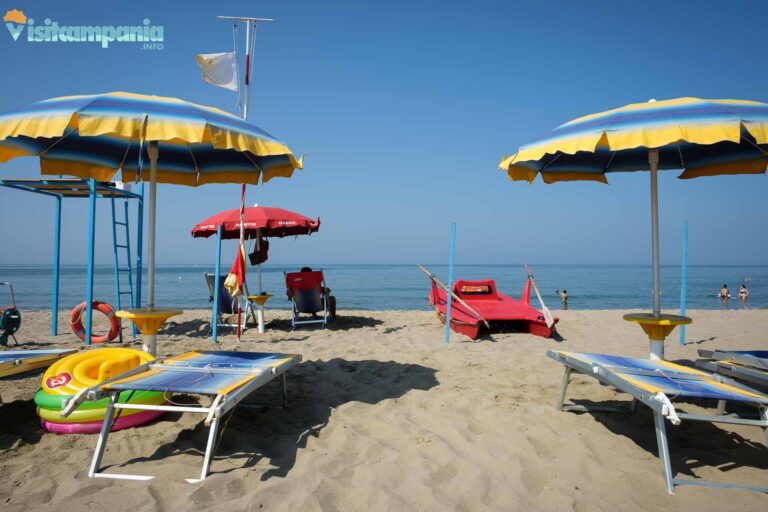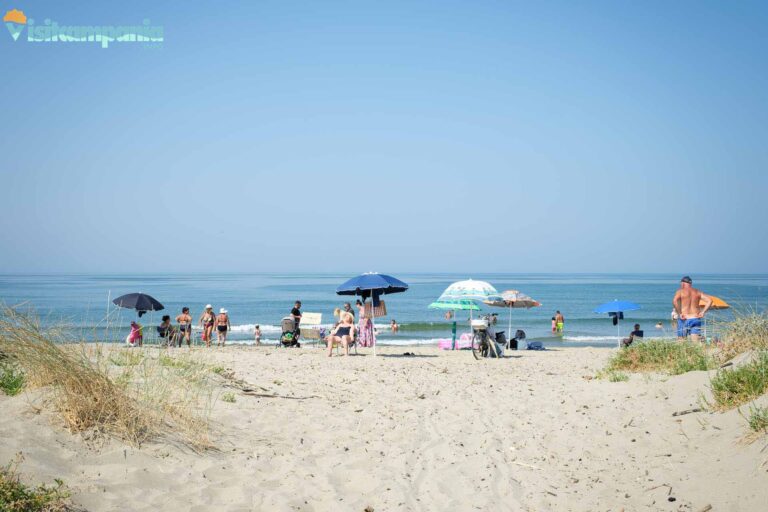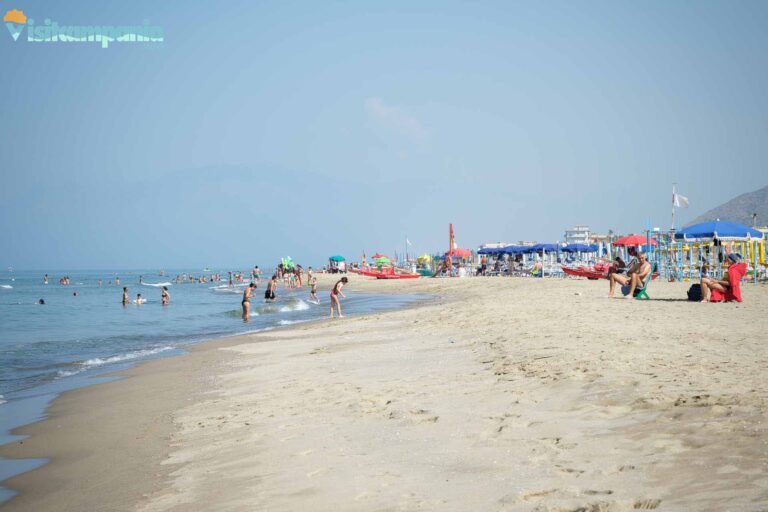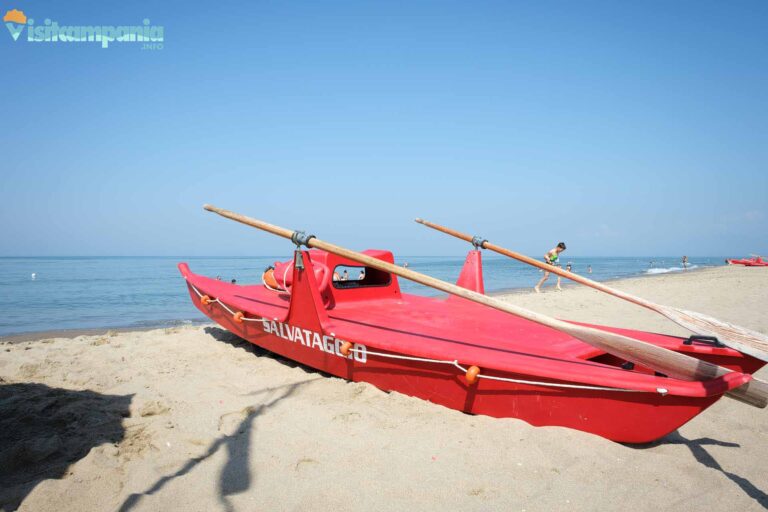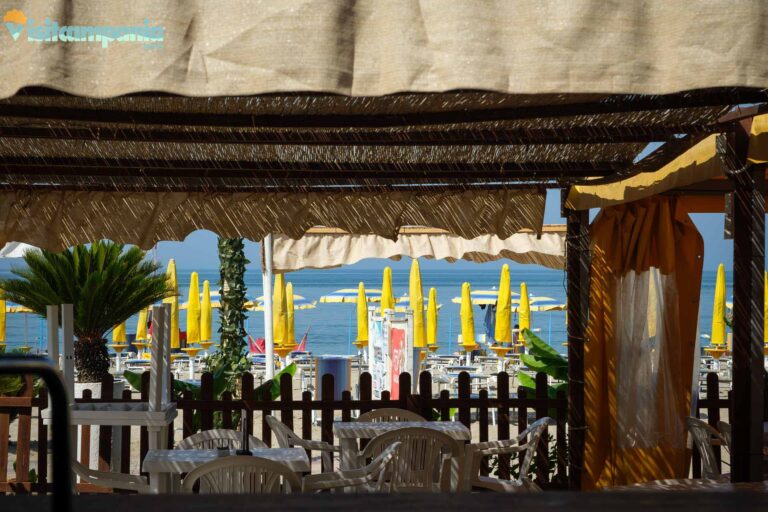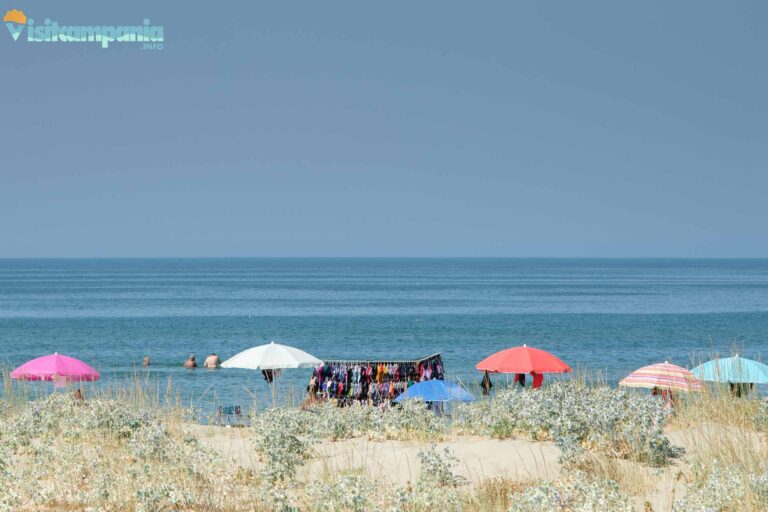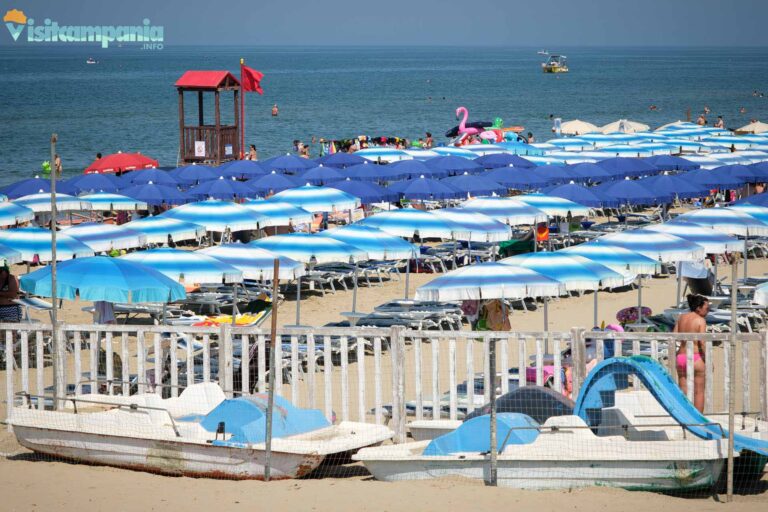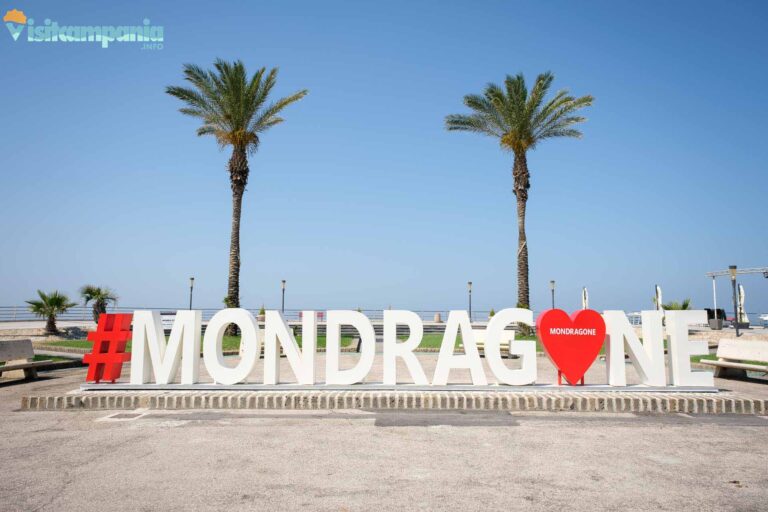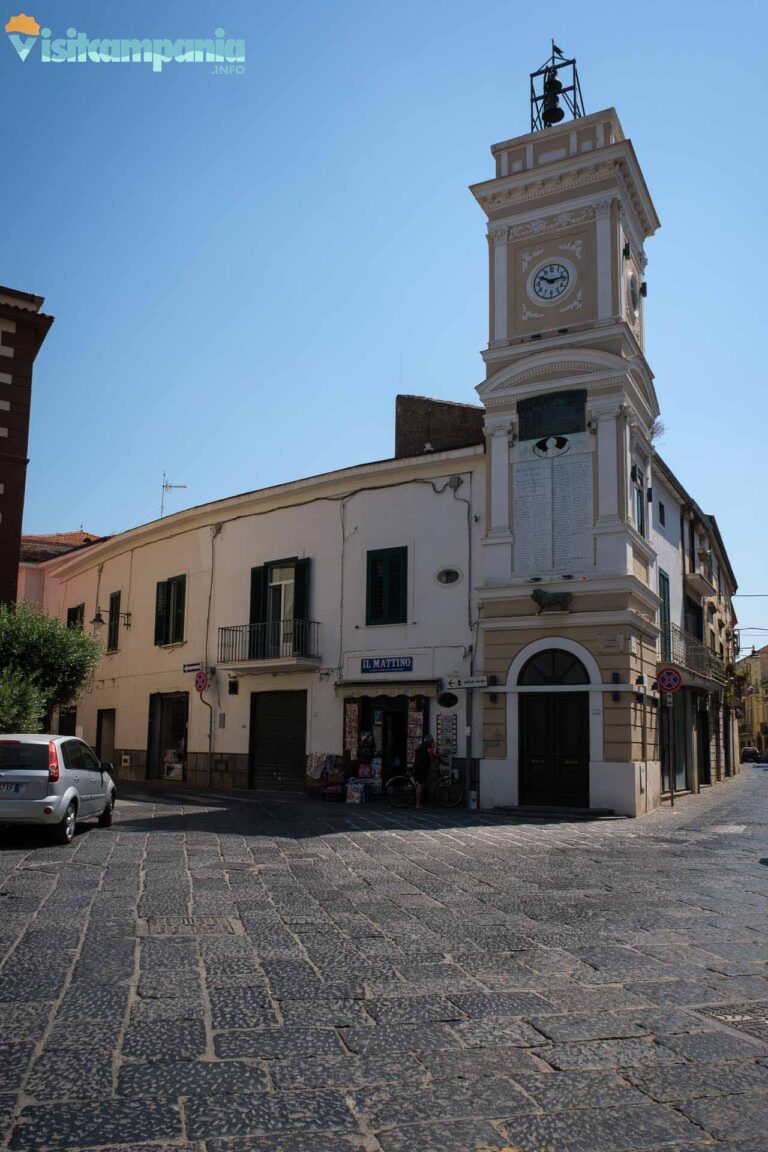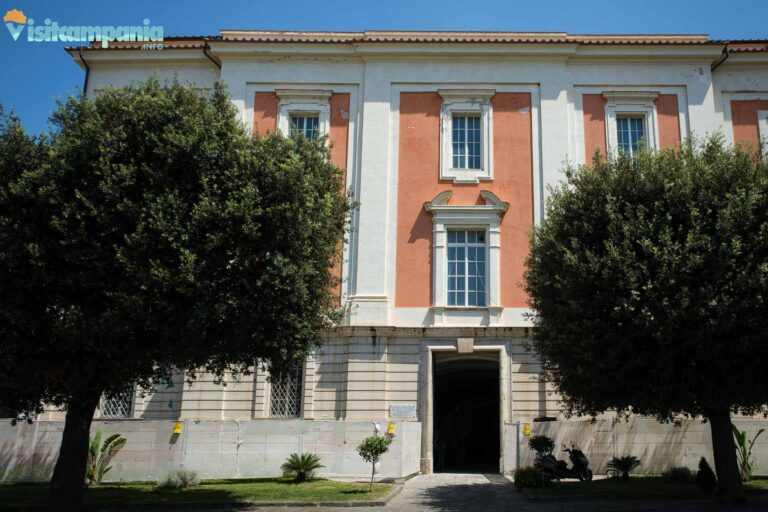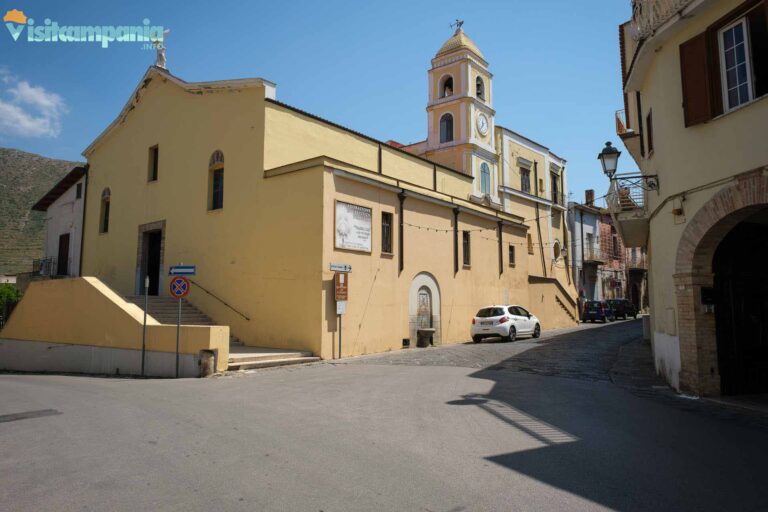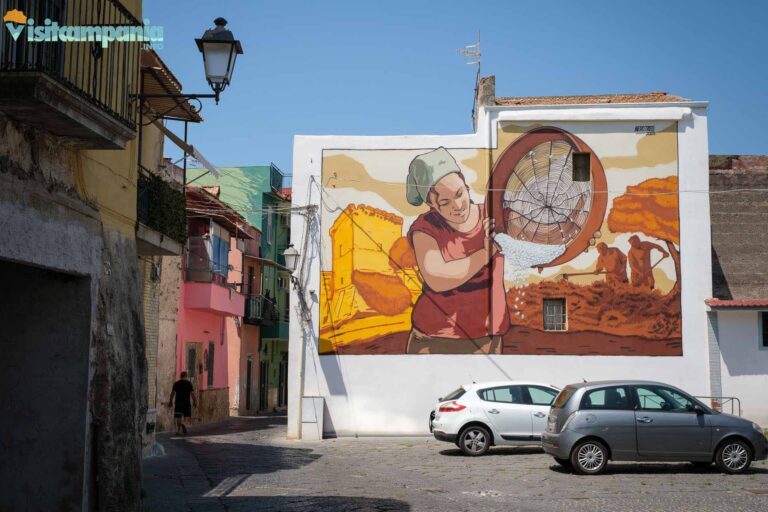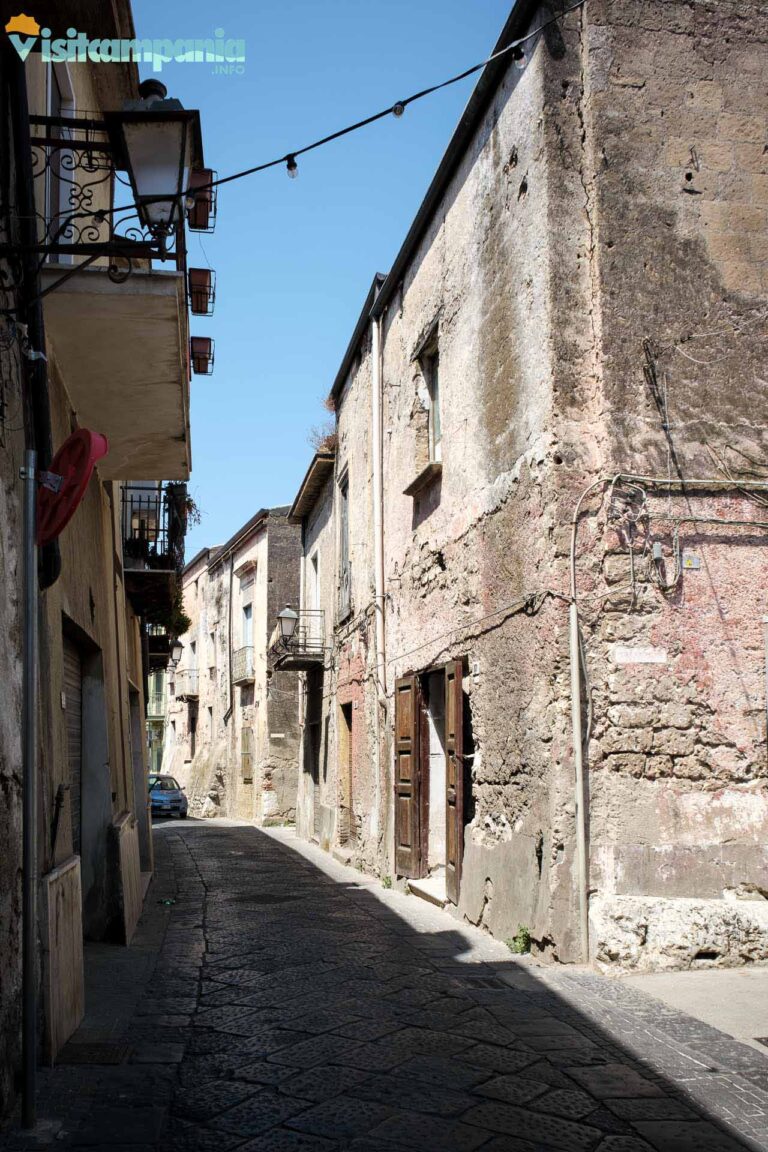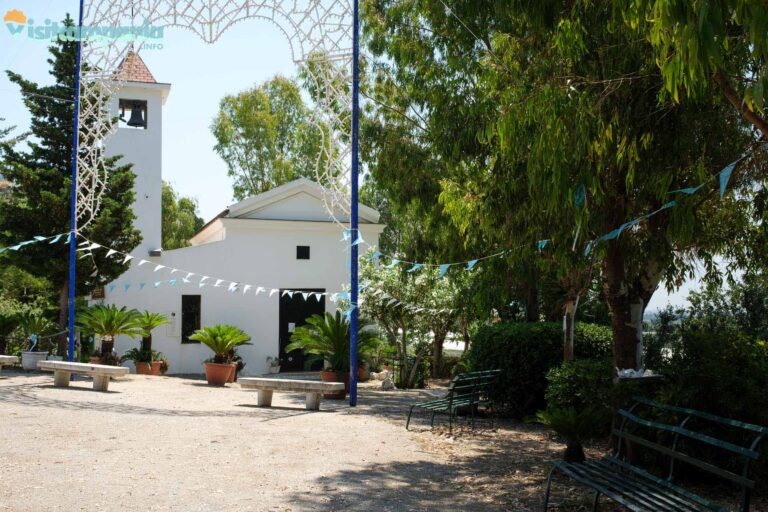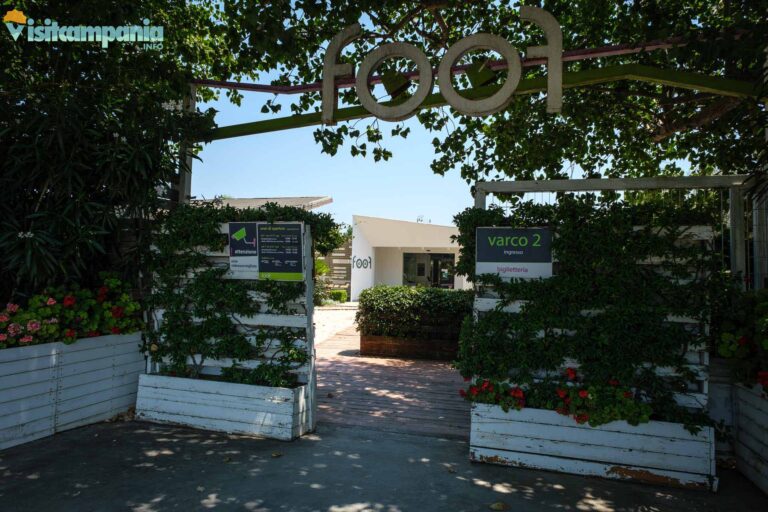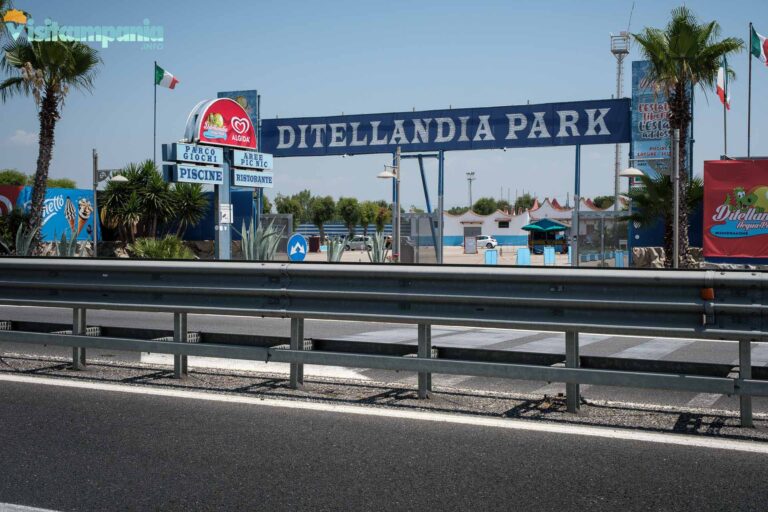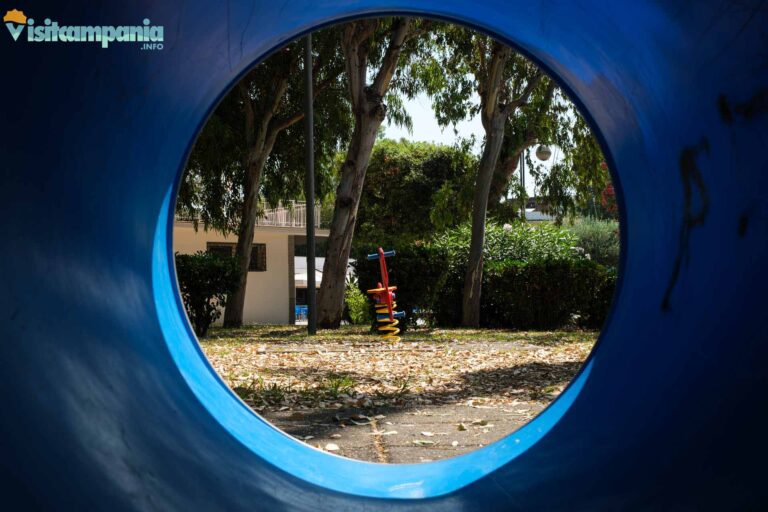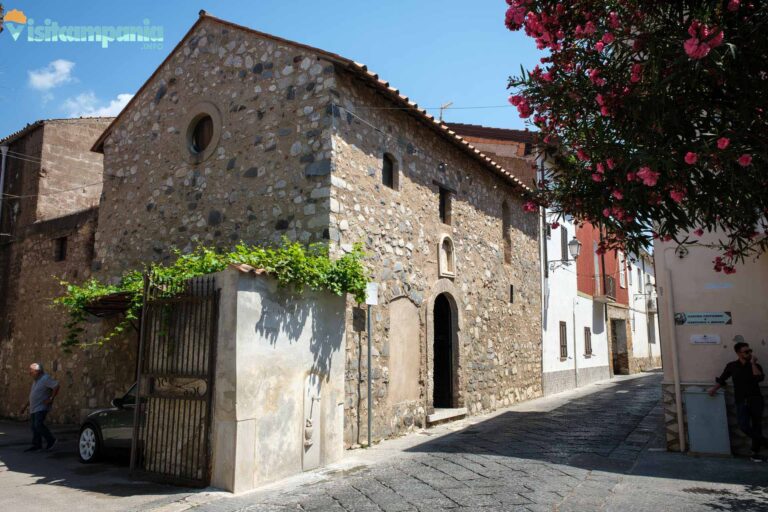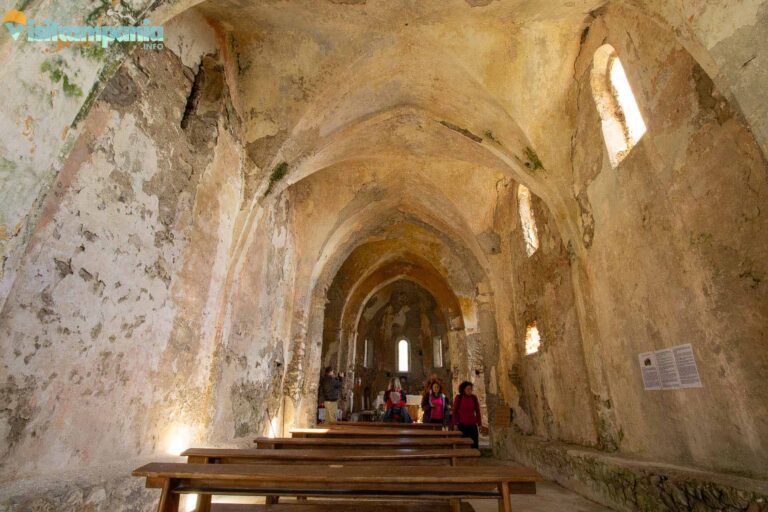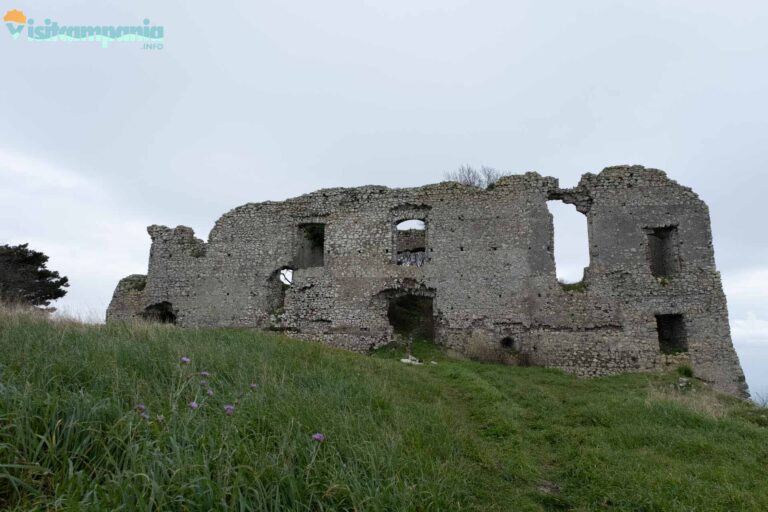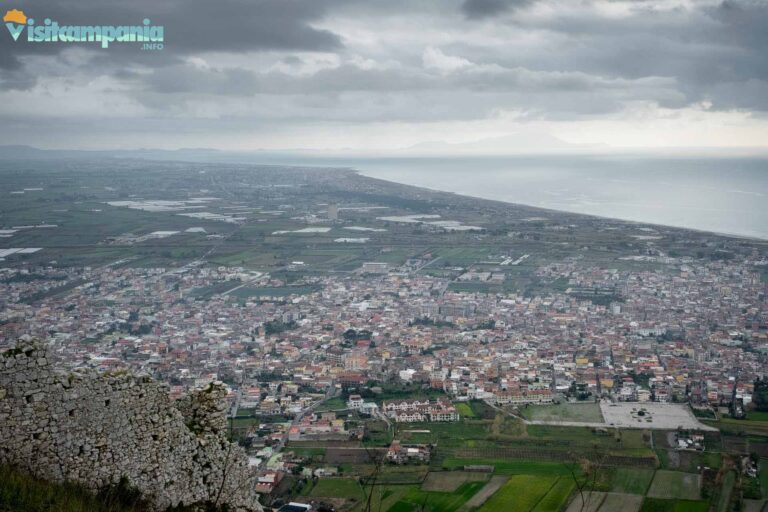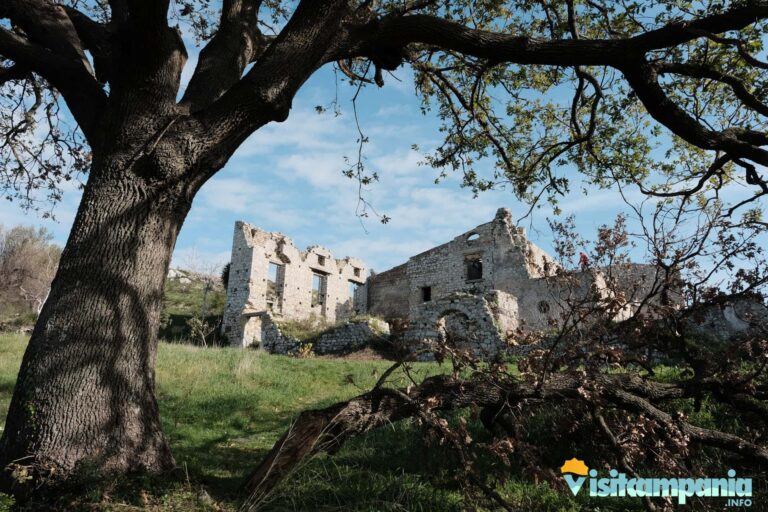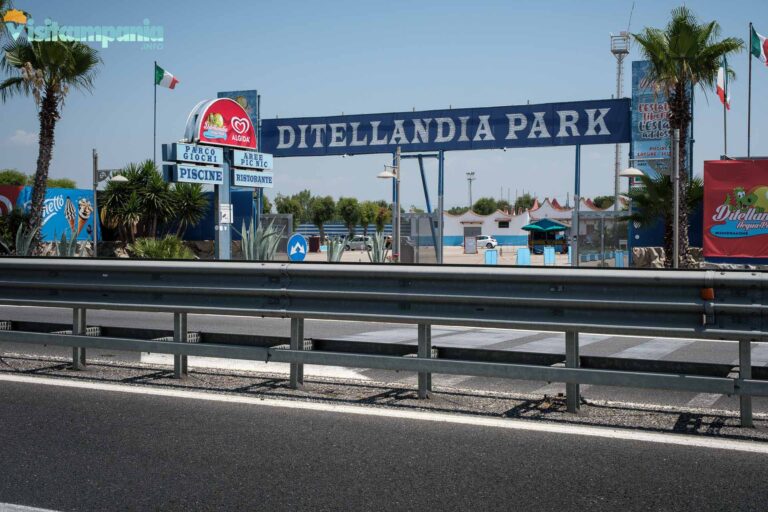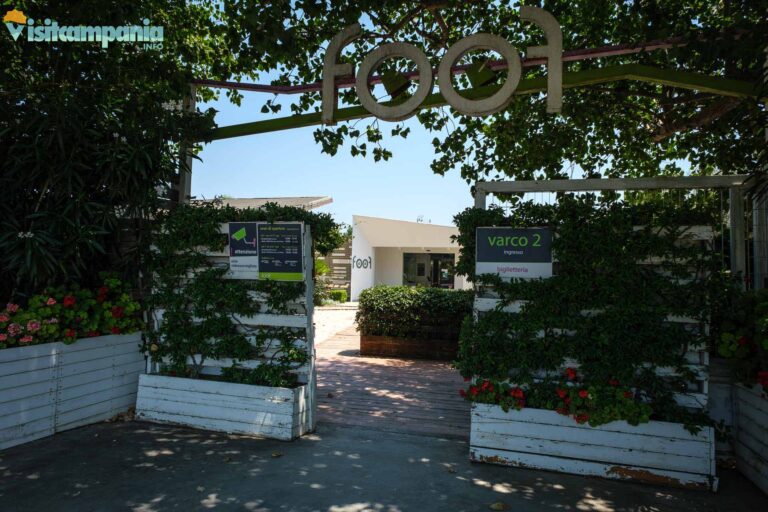What is Mondragone
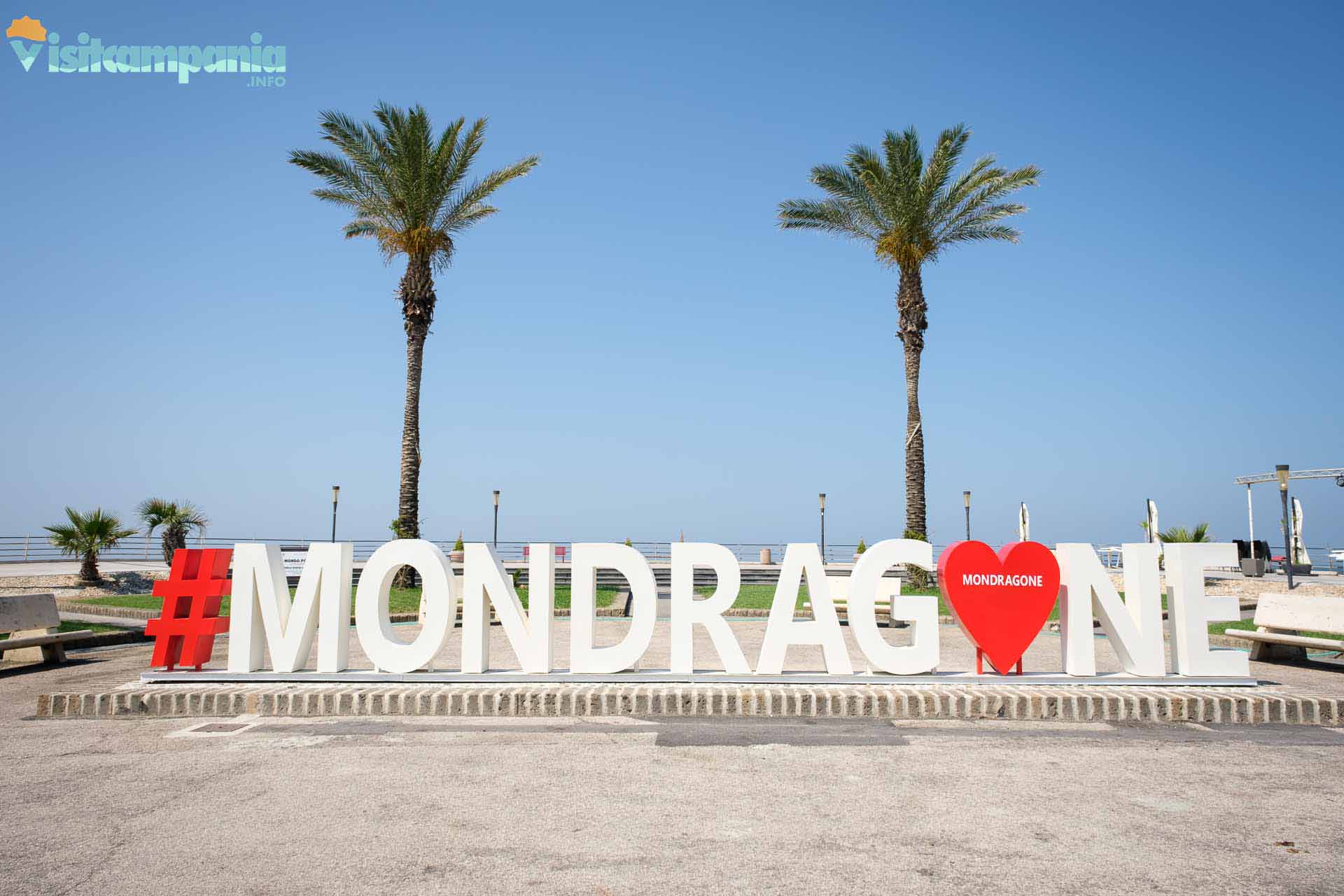 Mondragone, located on the Domitio coast in the province of Caserta, is a town of 28,731 inhabitants known for its beaches suitable for family tourism and characterized by affordable prices.
Mondragone, located on the Domitio coast in the province of Caserta, is a town of 28,731 inhabitants known for its beaches suitable for family tourism and characterized by affordable prices.
It is renowned for the production of mozzarella campana DOP and Falerno del Massico DOC wine.
The town extends between the Garigliano and Volturno rivers, with the Massico chain to the west and Monte Petrino in the center, on which stands the Rocca Montis Dragonis.
From the seafront you can admire the islands of Ischia, Procida and part of the Pontine islands.
Background
Mondragone has ancient origins, dating back to the Aurunci and the Romans, who founded Sinuessa in 296 BC. Famous for its thermal baths and Falerno wine, Sinuessa reached its peak with the inauguration of the Via Domiziana in the first century AD, but declined from the second century, and an earthquake in 375 prompted the survivors to build the Rocca Montis Dragonis on Monte Petrino.
In the Middle Ages, the city suffered several invasions, it was occupied by the Normans in the eleventh century and then by the Aragonese in the fourteenth century, when the fortress lost strategic importance.
The name Mondragone probably derives from Drogone d’Altavilla, while a legend speaks of a dragon on Monte Petrino.
During the Second World War, Mondragone resisted the German occupation, suffering heavy losses between 21 and 29 October 1943, and was awarded the gold medal for civil valor by President Carlo Azeglio Ciampi.
What to do and see in Mondragone
Mondragone, located on the northern coast of Campania, is known for its beach activities and summer entertainment. However, there is no shortage of historical and artistic testimonies of great interest such as the medieval district of Sant’Angelo and the Rocca Montis Dragonis.
The beaches of Mondragone
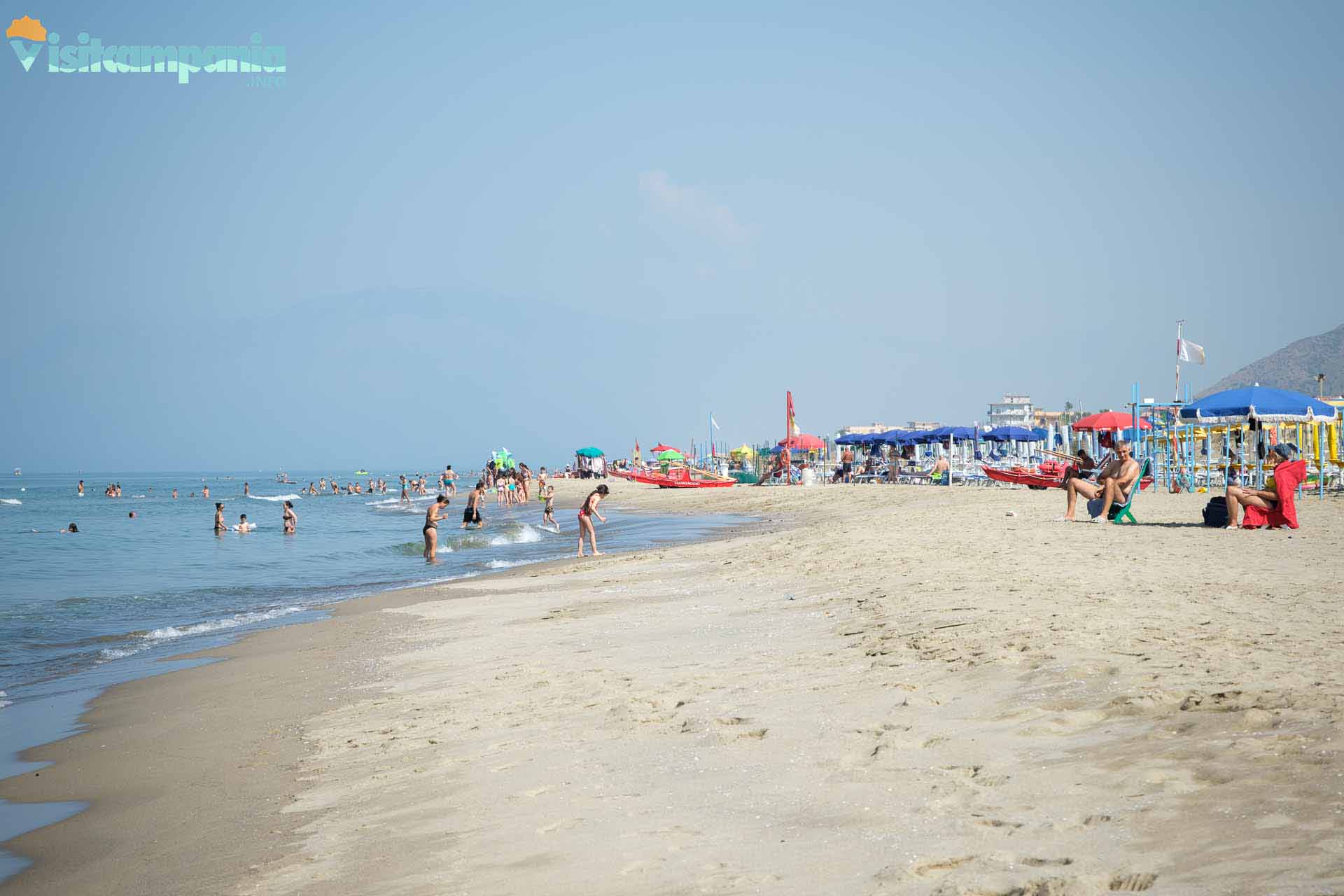
The coastline of Mondragone extends for about eight kilometers, from the hamlet of Le Vagnole in the north to the hamlet of Pineta Riviera in the south. The beach, wide and sandy, has a shallow seabed that slopes slowly. The Lungomare Caracciolo, located in the center and crossed by a wide cycle path, is full of bars ideal for snacks and aperitifs, and offers both stretches of free beach and equipped beaches. Private and public parking lots along the entire seafront make it easy to stop.
Ditellandia Acquapark
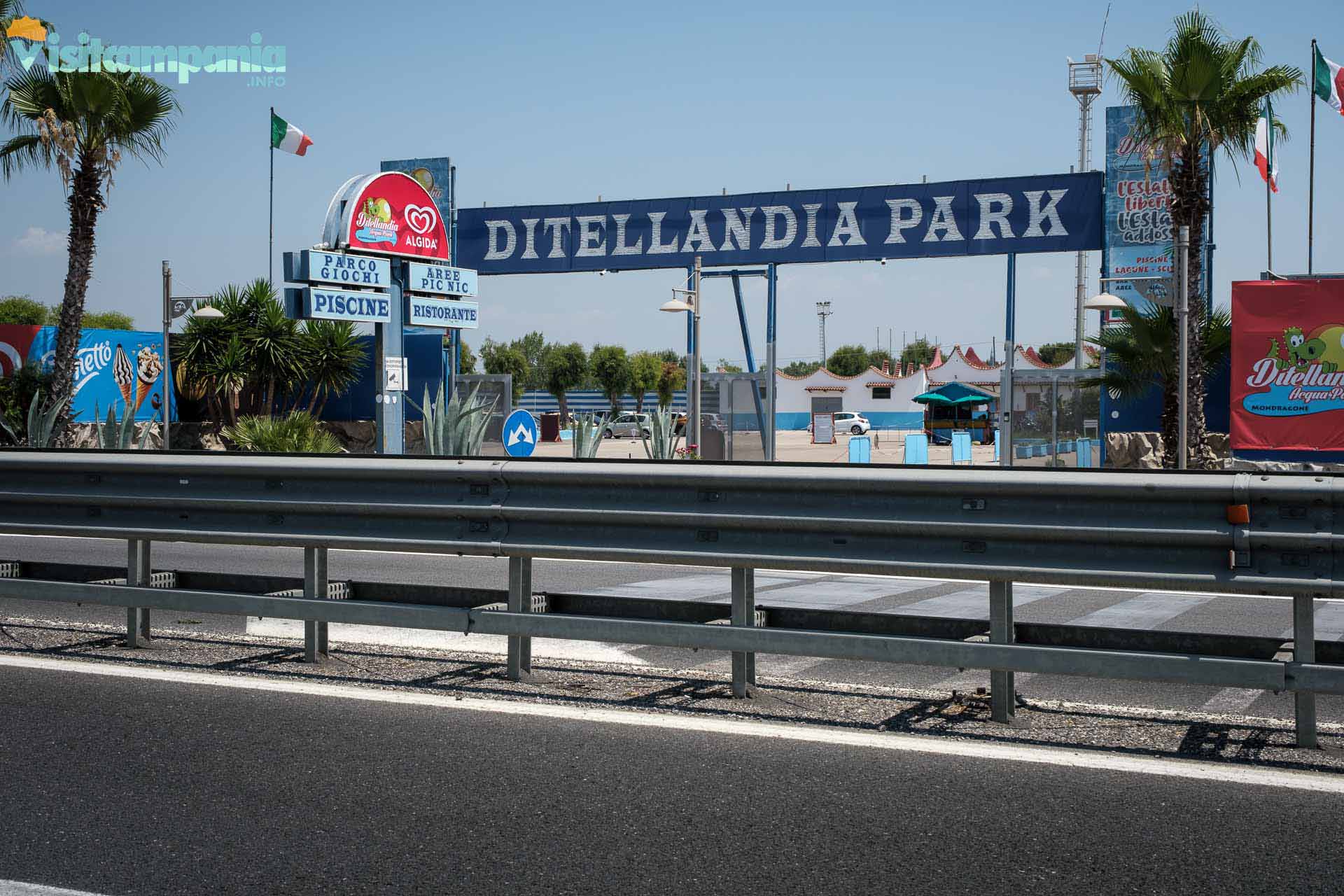 The Ditellandia water park, located in Pescopagano, a hamlet of Mondragone, is an ideal destination for summer holidays. Open since 1991, it offers several attractions that include the toboggan slide, three Kamikazes, four four-slide tracks, five children’s slides and ten swimming pools, including an Olympic-size and a lagoon. Leisure spaces with trampolines ensure fun for the whole family.
The Ditellandia water park, located in Pescopagano, a hamlet of Mondragone, is an ideal destination for summer holidays. Open since 1991, it offers several attractions that include the toboggan slide, three Kamikazes, four four-slide tracks, five children’s slides and ten swimming pools, including an Olympic-size and a lagoon. Leisure spaces with trampolines ensure fun for the whole family.
Foof – Dog Park and Museum
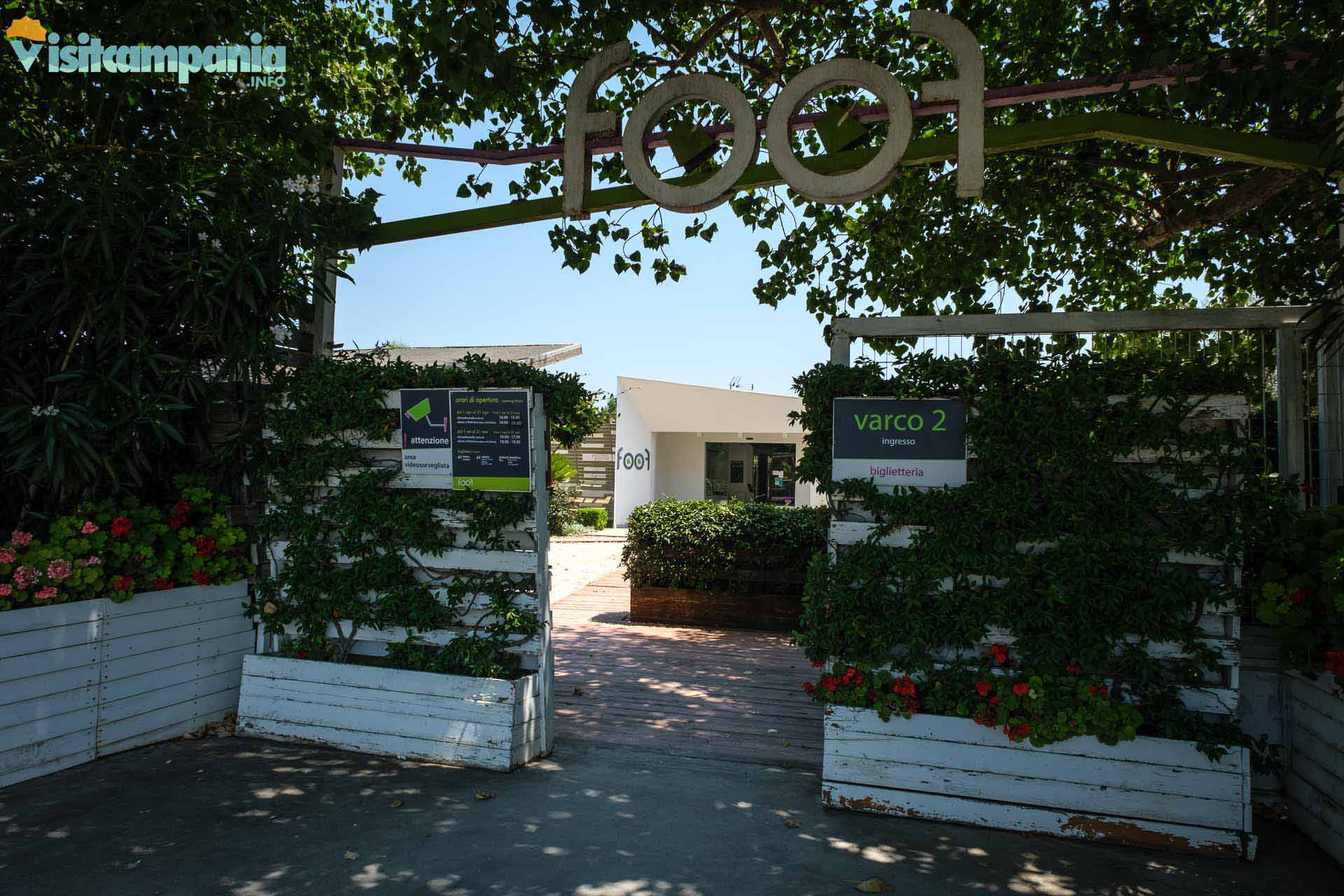 The Foof Museum Park, the first museum in Italy dedicated entirely to dogs, celebrates the relationship between dog and man. Located on over 70,000 square meters, it tells the evolution of the dog, the selection of breeds and their historical roles through finds and reconstructions. The museum, with thematic sections such as history, cinema, science, art and collars, raises awareness against the mistreatment of dogs and enhances the bond with humans. It also offers a large collection of dog collars and photographs of famous people. The park has educational workshops, a play area, refreshments, an amphitheater, spaces for mobility dogs, and covered picnic areas.
The Foof Museum Park, the first museum in Italy dedicated entirely to dogs, celebrates the relationship between dog and man. Located on over 70,000 square meters, it tells the evolution of the dog, the selection of breeds and their historical roles through finds and reconstructions. The museum, with thematic sections such as history, cinema, science, art and collars, raises awareness against the mistreatment of dogs and enhances the bond with humans. It also offers a large collection of dog collars and photographs of famous people. The park has educational workshops, a play area, refreshments, an amphitheater, spaces for mobility dogs, and covered picnic areas.
Sant’Angelo district
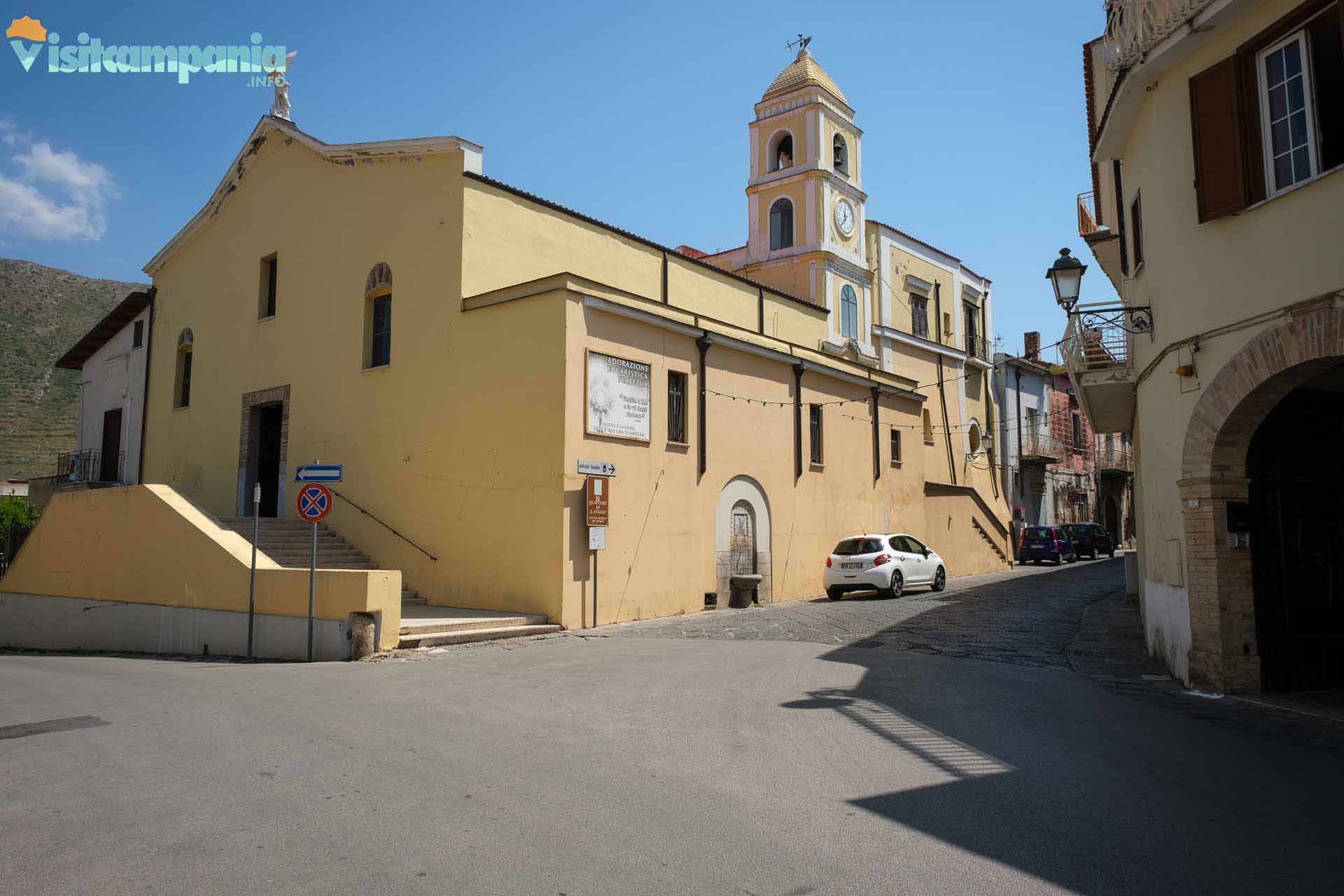 In the fourteenth century, the inhabitants of the Rocca on Monte Petrino moved to the valley, creating the village “Villa dei Marchi”. Over time, this village became one of the most important villages of Mondragone, known today as Casale di Sant’Angelo, the oldest place in the city. Not adequately enhanced, however, it houses historic buildings, such as the Ducal Palace (not open to visitors internally), the Biagio Greco civic archaeological museum, the church of San Michele extra moenia in Romanesque-Gothic style and the medieval oratory of San Mauro Abate.
In the fourteenth century, the inhabitants of the Rocca on Monte Petrino moved to the valley, creating the village “Villa dei Marchi”. Over time, this village became one of the most important villages of Mondragone, known today as Casale di Sant’Angelo, the oldest place in the city. Not adequately enhanced, however, it houses historic buildings, such as the Ducal Palace (not open to visitors internally), the Biagio Greco civic archaeological museum, the church of San Michele extra moenia in Romanesque-Gothic style and the medieval oratory of San Mauro Abate.
Monastery of Sant’Anna a Monte
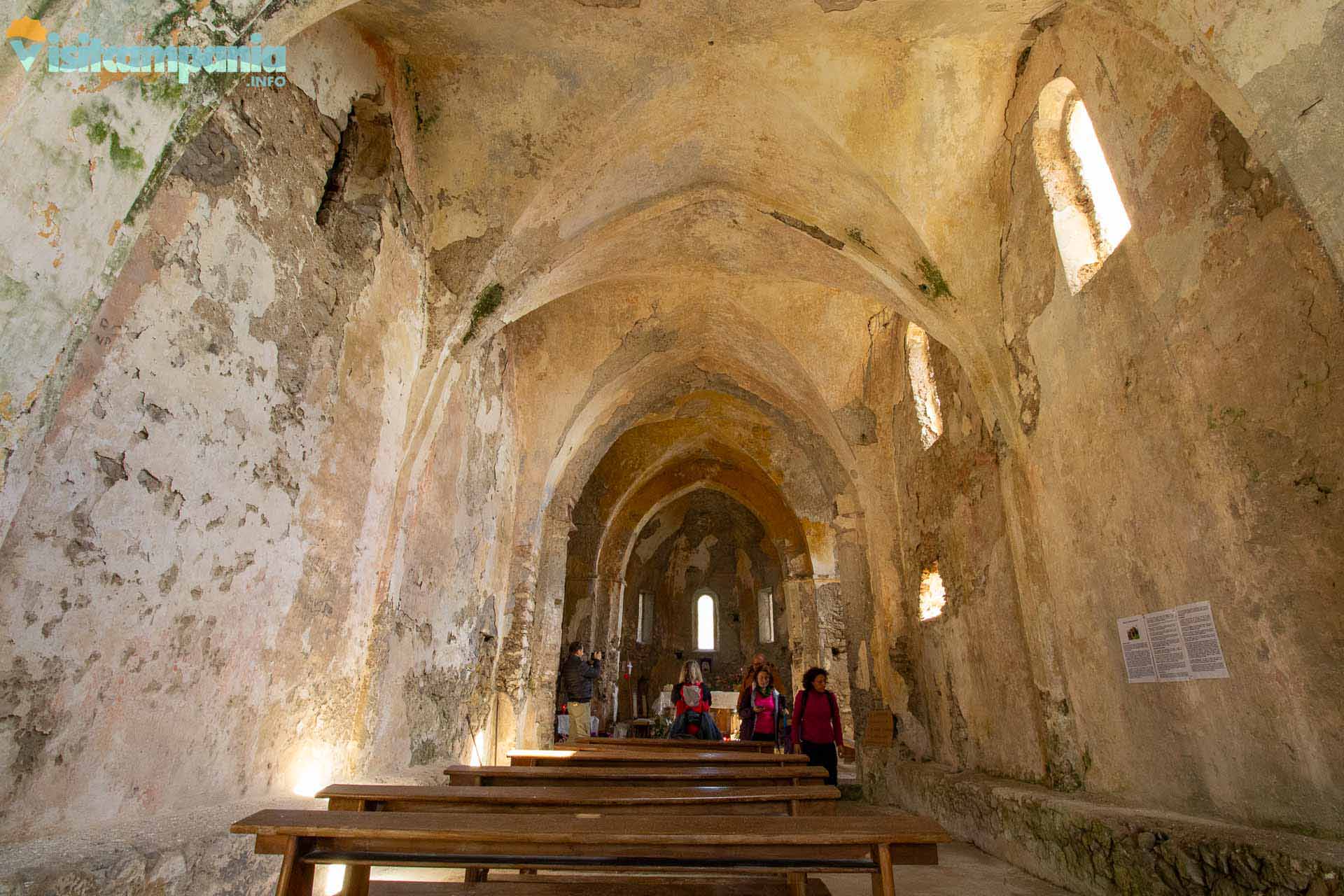 The Monastery of Sant’Anna a Monte, located on Monte Crestagallo and known as “de Aquis Vivis”, was built in the fourteenth century on land donated by Sancha d’Aragona, queen consort of Naples. Despite the decadence that began at the end of the fifteenth century, the abbot Nicola da Salerno attempted a renovation in the eighteenth century. In the nineteenth century, the property became private until the 80s of the twentieth century, when it was donated to the Diocese of Sessa Aurunca. The monastery still needs renovation and enhancement work. Every July 26, the parishioners of San Rufino celebrate St. Anne at the monastery. The monastery can also be reached by car and is located on the path of the Casertano Gods path .
The Monastery of Sant’Anna a Monte, located on Monte Crestagallo and known as “de Aquis Vivis”, was built in the fourteenth century on land donated by Sancha d’Aragona, queen consort of Naples. Despite the decadence that began at the end of the fifteenth century, the abbot Nicola da Salerno attempted a renovation in the eighteenth century. In the nineteenth century, the property became private until the 80s of the twentieth century, when it was donated to the Diocese of Sessa Aurunca. The monastery still needs renovation and enhancement work. Every July 26, the parishioners of San Rufino celebrate St. Anne at the monastery. The monastery can also be reached by car and is located on the path of the Casertano Gods path .
Rocca Montis Dragonis
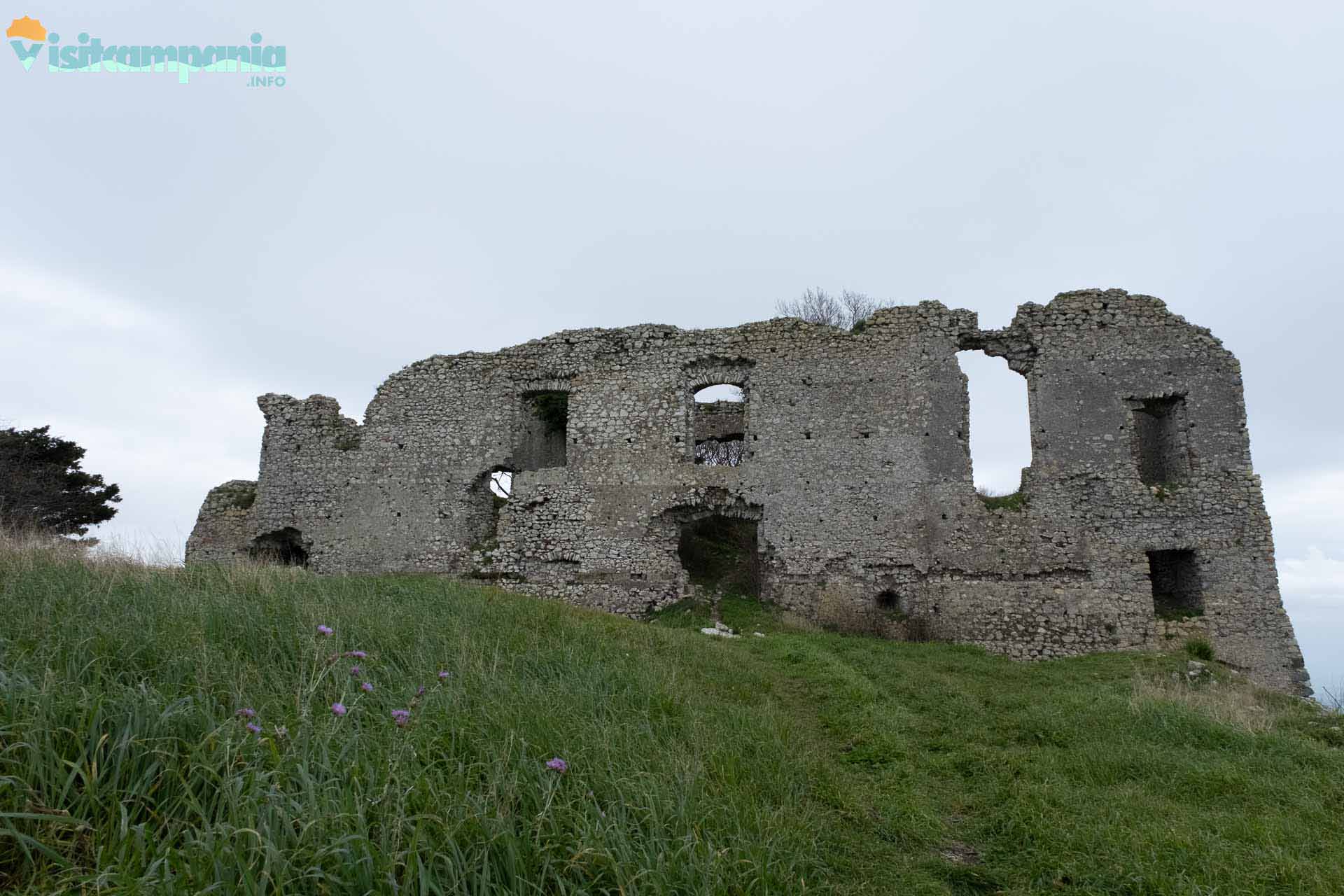
The Rocca Montis Dragonis, built between the eighth and ninth centuries by the veterans of Sinuessa, stands on Mount Petrino overlooking the city of Mondragone. Its square and circular towers bear witness to buildings from different eras, from the High to the Late Middle Ages. The current castle, quite ruined despite some restoration work, is an imposing two-storey square building, located on the steep part of the mountain with foundations that follow the shape of the rock. Abandoned between the fifteenth and sixteenth centuries, since 2001 the fortress has been the subject of archaeological excavations financed by the Municipality of Mondragone, which are bringing to light a medieval village whose remains are exhibited in the Civic Archaeological Museum. During the feast of St. Michael the Archangel, at the beginning of October, the castle is illuminated, creating an evocative spectacle. The Rocca cannot be reached by car but it is necessary to walk an uphill stretch of the Casertano Gods path .
Belvedere Church
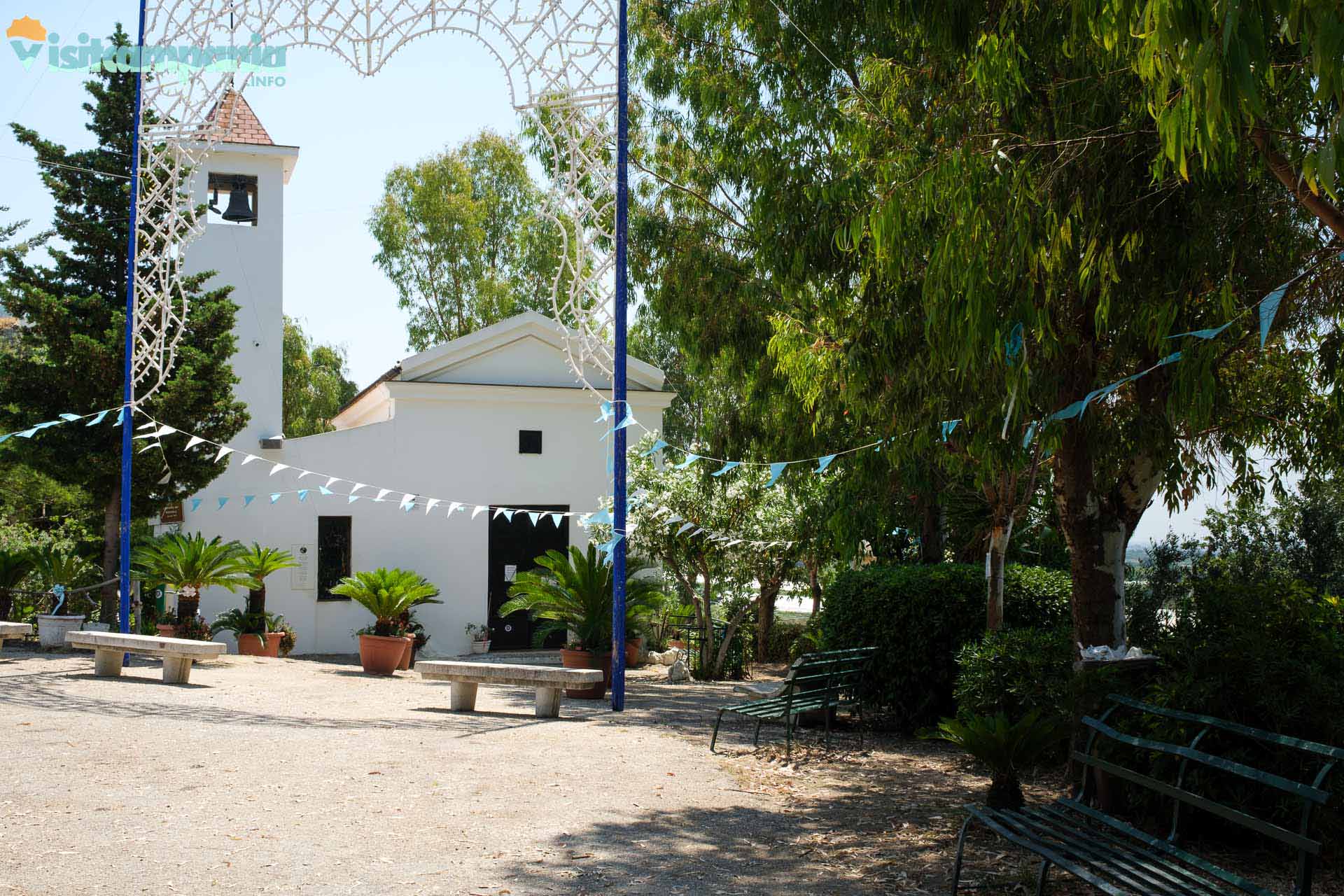
The Church of the Belvedere in Mondragone, dating back to the thirteenth century, is located at the foot of Monte Massico and originally housed the Byzantine icon of the Madonna Incaldana, protector of the city. Sacked in the sixteenth century, the church was then run by the Carmelite Fathers until the seventeenth century. The painting of the Madonna, transported to Mondragone on a cart pulled by oxen to save it from the risk of attacks, is now in the Sanctuary of Maria Santissima Incaldana, and every Monday in Albis the transport is commemorated with a procession. The church, recently rebuilt, is simple and with a rectangular plan, with white facades, a bell tower, a marble altar and a semicircular apse with a fragmented fresco of Saints and angels. Today it houses a copy of the painting of the Madonna Incaldana. The church, reachable by car, is the starting point of the Caserta path of the Gods .
Biagio Greco Civic Archaeological Museum
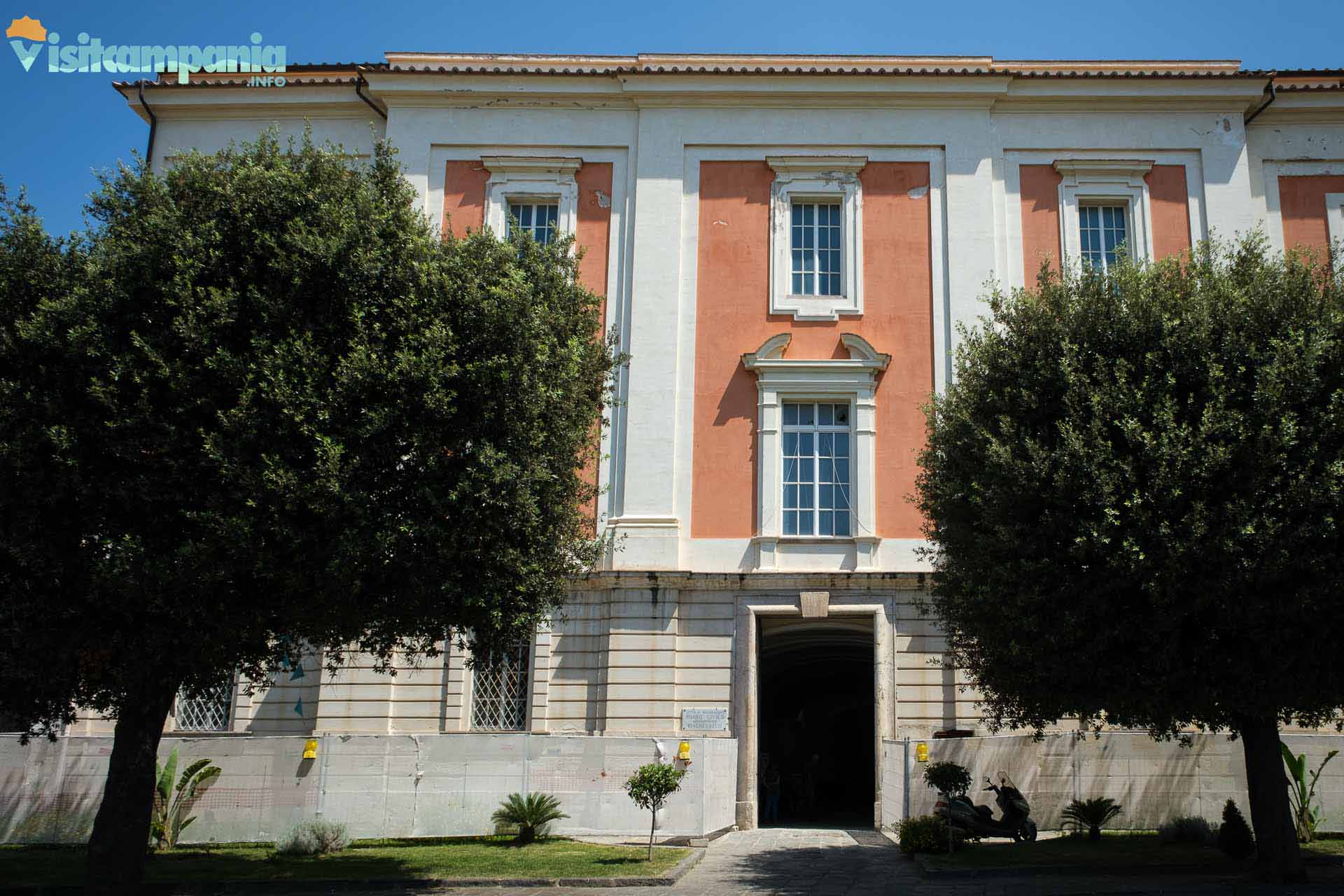
The Biagio Greco Civic Archaeological Museum, inaugurated in 2000 and recognized as a Museum of Regional Interest in 2007, houses five rooms with artifacts found in the area, organized chronologically from Prehistory to the Middle Ages.
The museum itinerary starts from the prehistory of 30,000 years ago, crosses the Roman period of the colony of Sinuessa in 296 BC, with grave goods, vases, votive offerings, oil lamps, coins and the statue of Apollo musagete of the 2nd century AD, and arrives at the medieval period between 1100 and 1500, with finds that include ceramics, glass, fibulae, weapons, dice, jewelry, coins, frescoes, burials and parts of musical instruments.
What to drink and eat in Mondragone
Buffalo Mozzarella from Campania PDO

Mondragone is renowned for the artisanal production of Mozzarella di Bufala Campana DOP, the so-called white gold of Campania.
If you pass by here you can’t help but taste it.
It is recognizable by its porcelain white color and smooth, compact surface.
It has a characteristic scent that recalls freshly milked buffalo milk, and when cut it releases drops of whey that indicate freshness and high quality.
The texture is resistant but turns soft to the bite, while the flavor is strong and delicate, offering a unique taste experience that has nothing to do with cheap industrial products.
Falerno del Massico Wine
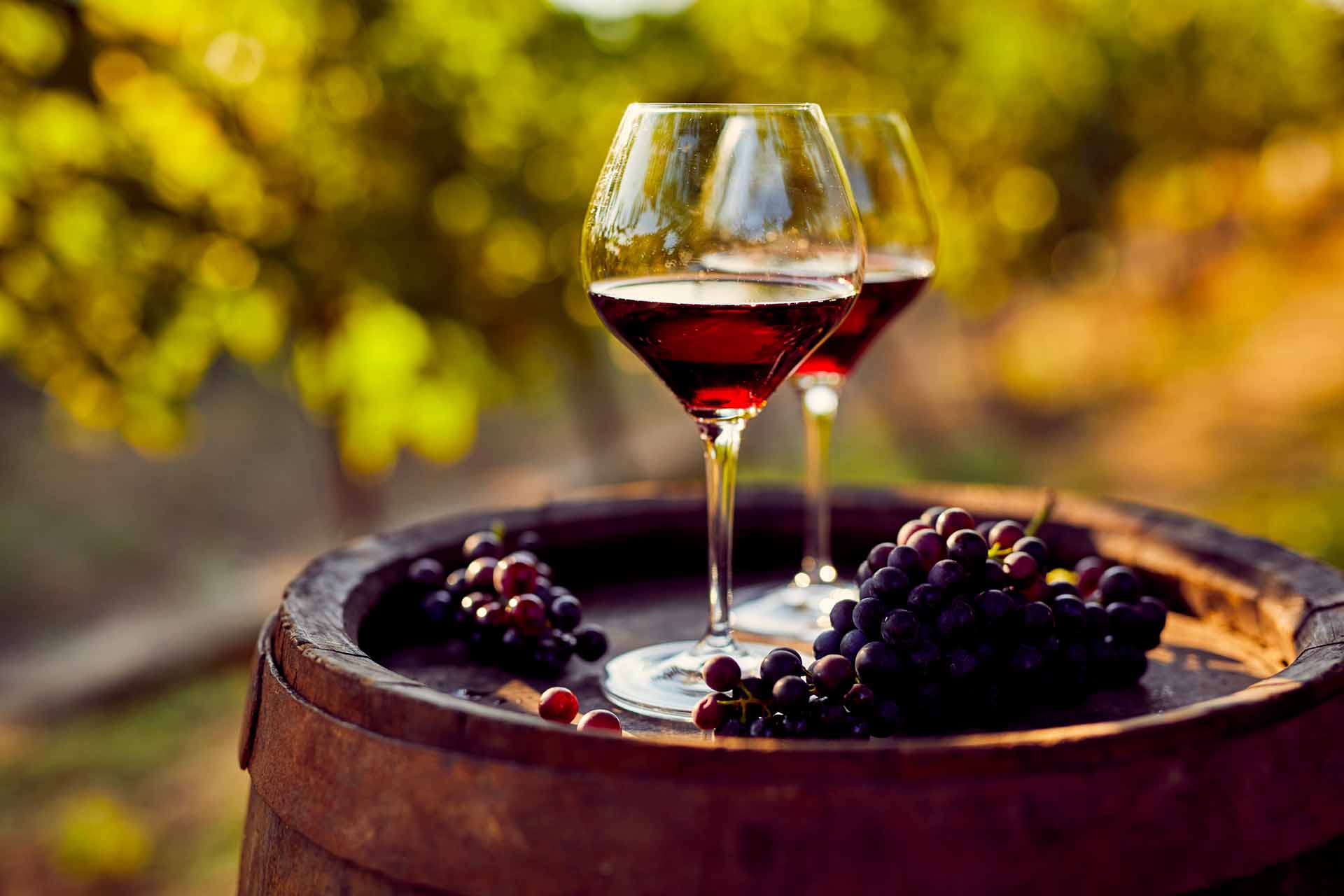 Falerno del Massico wine, produced in the northern part of the province of Caserta, has a history dating back to ancient Rome, where it was considered the noblest of wines. Legend has it that Bacchus transformed the slopes of Mount Massico into vineyards. Historically, Falerno wine was prized for its high quality, and Pliny the Elder claimed that a good Falerno, when brought close to a flame, caught fire. In 1989, Falerno del Massico obtained DOC recognition. Today, Falerno del Massico DOC is a flagship wine of Campania, available in both white (from Falangina grapes) and red (from Aglianico and Piedirosso, with additions of Primitivo and Barbera). The vineyards, located in the municipalities of Mondragone, Falciano del Massico, Carinola, Sessa Aurunca and Cellole, benefit from volcanic soils and proximity to the sea, which guarantees an ideal climate for the ripening of the grapes.
Falerno del Massico wine, produced in the northern part of the province of Caserta, has a history dating back to ancient Rome, where it was considered the noblest of wines. Legend has it that Bacchus transformed the slopes of Mount Massico into vineyards. Historically, Falerno wine was prized for its high quality, and Pliny the Elder claimed that a good Falerno, when brought close to a flame, caught fire. In 1989, Falerno del Massico obtained DOC recognition. Today, Falerno del Massico DOC is a flagship wine of Campania, available in both white (from Falangina grapes) and red (from Aglianico and Piedirosso, with additions of Primitivo and Barbera). The vineyards, located in the municipalities of Mondragone, Falciano del Massico, Carinola, Sessa Aurunca and Cellole, benefit from volcanic soils and proximity to the sea, which guarantees an ideal climate for the ripening of the grapes.
Excursions around Mondragone
Mondragone is an ideal destination to enrich a beach holiday with excursions to seaside and cultural resorts. Less than an hour’s drive away are several interesting destinations: Gaeta 42 km north on the Riviera of Ulysses in Lazio, Caserta 48 km inland with the famous Royal Palace, and Pozzuoli 41 km south, from which you can set off on an excursion to the island of Procida, which can also be done in a day. Continuing beyond Pozzuoli, you reach Naples at 55 km. Finally, Pompeii, with its archaeological park and the Marian sanctuary, is 83 km away, which can be covered in just over an hour.

